Genre: Sports Developer: TecMagik Publisher: TecMagik Players: 1-2 Released: 1992
Andre Agassi: eight-time Grand Slam winner, oldest World No. 1 in tennis history, and arguably the sport’s most famous player. Anyone who’s followed tennis over the past three decades knows his story well – and many people who don’t care one whit about tennis know it too, especially since the publication of his autobiography Open in 2010.
Much has been made of Agassi’s mythic journey from “punk” to champion, and then from has-been to champion once again, culminating in his tearful retirement in 2006 and new role as elder statesman of the game. This mythology is probably a bit exaggerated, but Agassi has given generously to charitable causes – some sources say he’s given more than any other professional athlete in history – and he seems deeply committed to his work on behalf of disadvantaged kids.
Also revealed in Agassi’s autobiography were some darker moments in his past, including his father’s abusive and erratic behavior, his own use of crystal meth, and the fake story he concocted about a spiked drink to escape the consequences of his failed drug test. Most scandalously of all, he wrote that “I hate tennis, hate it with a dark and secret passion and always have.”
With all these damaging revelations, it’s hard to believe Agassi is holding anything back in his book, but there’s at least one iniquitous incident in his past that goes unmentioned in Open. I refer, of course, to Andre Agassi Tennis, released by TecMagik in 1992 for the Sega Genesis and which purports to offer “net-blasting digitized action” that, according to Andre’s own blurb on the back, “takes the same nerve and strategy it takes to be a world-class player.” (TecMagik also released similar versions for the Game Gear and Master System, but their SNES release under the same name is a completely different game.)
Andre Agassi Tennis features a roster of eight players, including Agassi. None of the other seven are real-life pros, but some are clearly inspired by other American players like Chris Evert, aka “Carol Ark”. (The Chinese-American character is “Bob ‘Bit’ Chin” – a sophomoric nickname that may be a jab at Michael Chang, whom Agassi famously disliked.)
In the game’s Tournament mode, these players battle through a season of four events in an attempt to reach the #1 ranking. These nameless tournaments are all mixed-gender events, which is an interesting twist, and each takes place on a different surface (hard, clay, grass, or indoor). All matches are best-of-three sets, and all tournaments are four rounds long.
Each victory earns money which can be used after the event to increase the player’s skills. The game also provides the option of playing in “Skins” mode, in which the stake for each match is built up stroke-by-stroke in the course of gameplay, with more money awarded for longer points or for serving aces. Finally, there’s a Practice mode in which the player can work with a tennis ball machine to hone his or her groundstrokes (though not the serve).
Except for Skins mode and the fact that men and women play against each other, all this is fairly standard stuff. But there are some glaring omissions in Andre Agassi Tennis – things one expects to find in other tennis games but are absent here. For starters, there are no configuration options at all; instead, we get a menu item called “Secrets” which, if selected, informs us that “I lied about the secrets” and offers up a brief recap of the manual instead. So, changing the button assignments, or turning off the music or voice samples, literally isn’t an option.
Far worse is that Andre Agassi Tennis includes absolutely no save-game or password option of any kind: the game has to be completed in one sitting. If you win all four tournaments, at four rounds each, that means playing a minimum of 32 consecutive sets. Now, to the game’s credit, you can still finish the year at #1 without winning every match, and I was able to reach #1 despite getting knocked out in the first round of the French – er, I mean, the “clay court” event – and then winning the other three tournaments. But that still took about five hours of gameplay, and it’s both inhumane and insane that the game wouldn’t, at the very least, offer a password after each tournament.
Oh, and the game has no tiebreaks. None. This despite the fact that tiebreaks were introduced to tennis in the early 1970s and were essentially universal by the time Andre Agassi started his career. (The only exceptions are the final sets in Grand Slam matches – outside of the U.S. Open, which uses tiebreaks in all sets – and certain special events like the Davis Cup.) So, a game that’s already inordinately long is made even longer by this bizarre omission.
Now, if Andre Agassi Tennis were a great-looking game that sported a terrific gameplay engine, slick presentation, and silky-smooth controls, all of these issues could probably be forgiven. But within ten seconds of starting a match in Andre Agassi Tennis, you’ll discover that the opposite is true, on all counts. For starters, the court and digitized players look passable in still shots, but once in action your character moves in an erratic, herky-jerky fashion that’s vaguely reminiscent of the rotoscoped animation in games like Prince of Persia. There’s a significant lag between pressing the D-pad and seeing your character start to move, and his motion is slippery and full of odd “hitches,” as if he were running on ice.
Once you try to hit the ball, it’s even worse. Andre Agassi Tennis is essentially a two-button game, with one button for lobs (B) and one for everything else (A). (The C button can be used for an “immediate” swing, but it’s mostly useless.) In theory you control the power and placement of your shots, including the serve, by the length of time you hold down the button or D-pad (respectively). You’re supposed to time your swing by letting go of the button, whereupon the game will move you within range of the ball (if you’re close enough) and swing.
This control scheme can work, and has been used effectively in, among other titles, the excellent tennis mini-game in Super Monkey Ball 2 for GameCube. But here, it’s absolutely unworkable. First of all, the ball-striking animations are just as laggy as your character’s movement, and if you play “normally” it’s almost impossible to time your shots in any kind of effective way. Even if you make contact, you’ll often find that the ball flies off your racket, and what should be a routine forehand turns into an overhit mess. Sometimes it seems as if the game’s algorithms have foreordained that any balls hit from certain positions must go out, no matter what you do with the controls or how hard they’re hit. Backhands hit from the doubles alley in the ad court will inevitably drift wide or long, and the same goes for forehands hit from the opposite side. Serving is marginally more intuitive, since contacting the ball is easy enough, but the controls for placing the serve feel artificial and hard to calibrate, and any attempt at variety will usually result in serving to the wrong side of the court. Worst of all, neither the player nor the computer can handle balls hit directly at them, including serves into the body. Your character can pull off impossible dives, stretching Gumby-like to reach a passing shot that’s halfway across the court, but a simple shot right at their body will result, over and over again, in ineffectual flailing and a lost point.
As a result of these problems, gameplay in Andre Agassi Tennis can only be described as a kind of anti-tennis in which all the normal rules of the game are subverted. The laggy response and inability to handle body blows makes volleying suicidal, and though some defensive play is possible, it’s too hard to keep the ball in the court to assert yourself in baseline rallies. Consequently, the strategies required to win have nothing in common with the dynamics of a real tennis game, and instead revolve around taking advantage of the holes in the computer’s AI.
And those holes are gaping indeed, for the AI is utterly broken. However unintentionally, the best part of Andre Agassi Tennis is the absurdity of the computer’s behavior. Over and over again, the computer player will do things like running in the wrong direction, running in circles, swinging its racket at nothing at all, or simply standing ineffectually while a ball lands within easy reach…or slowly bounces right into their crotch. It varies somewhat by character (and the different computer opponents do have slightly different personalities), but most of them have trouble with lobs and drop shots, and watching the computer run around like a confused puppy while an easily-retrieved lob passes overhead is one of the funniest things I’ve ever seen on the Genesis.
The game’s audio is another source of unintentional humor. The ball-striking sound effects are clear, and many of the speech samples sound reasonably good, but the voice that announces the score is a monotone drone that (as another reviewer pointed out) is a dead ringer for the robot from Lost in Space. The title screen music is generic, and there’s no music during points; however, each character has a distinctive melody that plays when he/she wins a game. Some are tolerable, like Agassi’s tune, but Carol Ark’s theme is one of the most hideous things I’ve ever heard come out of the YM2612.
The same reviewer dubbed Andre Agassi Tennis “borderline unplayable,” and for any sane human being, that’s probably being too generous. But if you’re one of those mad souls who’s determined to get the better of the game, a winning strategy will gradually reveal itself. For example, if you can find the right rhythm on your serve, you can hit strings of aces right into the opposing player’s body, and the computer can’t (or won’t) do a thing about it. And the best way to return serve is often to stand right on the service line and block back drop shots, which will dribble over the net and die while the computer runs aimlessly in circles behind the baseline. It’s a lethally effective tactic — and one that would never, ever work in real life — but if that doesn’t do the trick, just throw up enough lobs and the computer will eventually self-destruct.
With enough practice, you’ll get a sense for those few moments when you can actually take a crack at the ball, nailing a weak serve for a crosscourt winner in true Agassi style. But to quote Agassi’s longtime coach Brad Gilbert, beating this game is all about “winning ugly,” and 90% of the time you’ll have to feed the computer a diet of junkballs, Gilbert-style, in order to win. Once you do claim victory and the #1 ranking, by the way, don’t expect an ending – the game just dumps you back to the title screen – though you do get a special screen with a secret code if you’re able to max out your player’s stats.
All told, it’s easy to believe that Andre Agassi hated tennis back in 1992, for I could hardly imagine a worse insult to the sport than this poorly-programmed, appallingly cynical cash-in. When the gods summon Andre for his final judgment, he may find that lending his moniker to Andre Agassi Tennis was a sin far worse than dabbling with recreational drugs or calling Pete Sampras a cheapskate. In such a case, there can be no punishment more fitting than the crime itself, so let’s hope for Andre’s sake that his charitable works help keep him from an afterlife spent playing his namesake.
SCORE: 1 out of 10

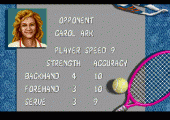
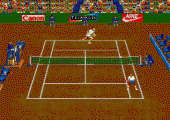
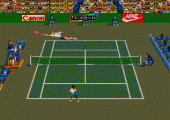
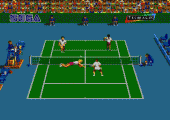
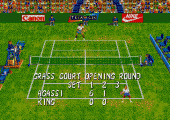
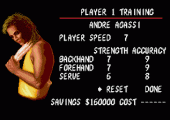
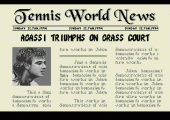
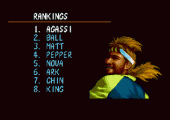
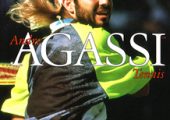
Recent Comments